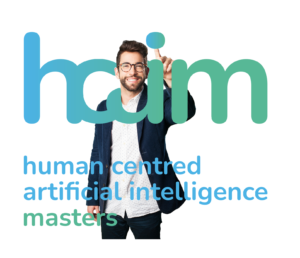In our aim to create a Human-Centred AI Master’s programme, the HCAIM Consortium follows the definition of AI HLEG: “The human-centric approach to AI strives to ensure that human values are central to how AI systems are developed, deployed, used and monitored, by ensuring respect for fundamental rights.”
To answer the requirements of this definition, the programme covers the technical, ethical and practical elements of artificial intelligence. We have designed our content around the three phases of the MLOps lifecycle – development, deployment and maintenance of machine learning models, thus producing three core modules in alignment with the above-mentioned ML-Ops phases: Modelling (Module A), Deployment (Module B), and Evaluation (Module C). We have added a fourth module (D) Graduation, to enable students to show that they can independently solve challenges proposed by the industry based on current needs and requirements related to the field of human-centred artificial intelligence. To support the students herewith, the lesson plan Research in Practice runs parallel to the other Modules, and guides the students from the start of the programme in their thesis process.
The structure of the programme is visualised in the table below.
| Module A | Module B | Module C | Module D | |
| Technical |
Foundations of AI |
Advanced AI: Deep Learning |
Future AI |
Master Thesis Project |
| Practical | AI Modelling | AI in Action: Organisational AI |
Socially Responsible AI | |
| Ethical | Ethics Fundamentals | Trustworthy AI | Compliance, Legality & Humanity |


